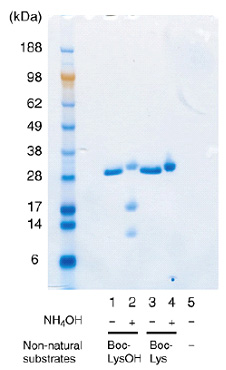Sep. 1, 2013
Procedure for producing ester-bond containing proteins
RIKEN No.: 07380
Inventor
Kensaku Sakamoto, Takatsugu Kobayashi, Tatuo Yanagisawa, Takahito Mukai and Shigeyuki Yokoyama (GSC)
Background
In mass production technologies of recombinant proteins based on E. coli, methods to express proteins with affinity tags such as His tag appended are widely practiced to purify target proteins. Since the fusion tag may have effects on physiological activity of the target proteins, the tag is generally enzymatically removed after purification. But these conventional methods have drawbacks: 1) high cost because they use expensive enzymes, and 2) amino acids of the tag remain on the target protein.
Summary

We used a technology to introduce non-natural amino acids, a technology owned by RIKEN Systems and Structural Biology Center, to develop another technology to incorporate a-hydroxy acid at defined sites in proteins produced by E. coli. In our method, an ester bond is incorporated between the target protein and the tag, and the tag can be removed by cleaving the ester bond under moderate conditions (pH9, 4 degrees C) without using enzymes. The resultant protein has no unnecessary sequence.
Furthermore, with use of E. coli strain (RF-zero strain) recently developed by RIKEN that can incorporate non-natural amino acids in a dramatically efficient manner, a large amount of target proteins incorporating a-hydroxy acid can be produced.
Confirmation of non-enzymatic resection of protein Ester bond incorporated into glutathione-S-transferase (GST) was broken by alkaline degradation in GST treated with alkali (Lane 2).
Merits
- Unwanted tag sequences are completely eliminated from the target proteins.
- Target proteins can be produced at low cost because the tags used for purification can be removed in a pH-dependent manner without using enzyme.
Applications
- Design of pro-drugs using pH-dependent resection
- Mass production of useful proteins
References
- 1.Japanese patent No.5419220
- 2.Kobayashi T, et al. J Mol Biol. 2009 Feb 6:385 (5): 1352-60
